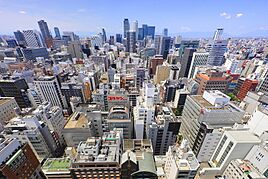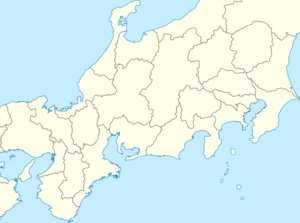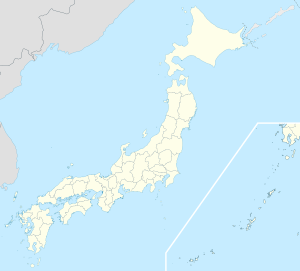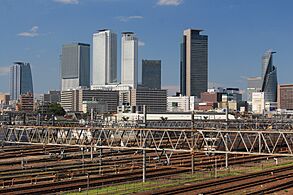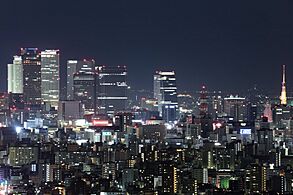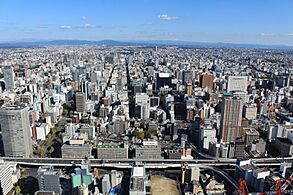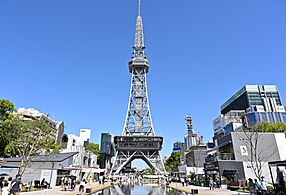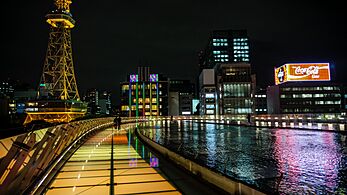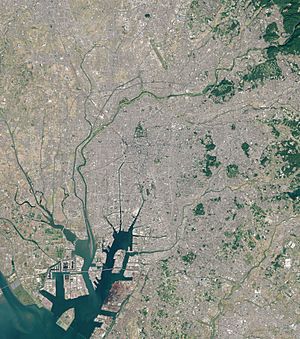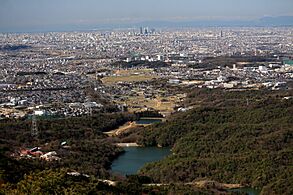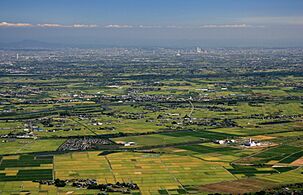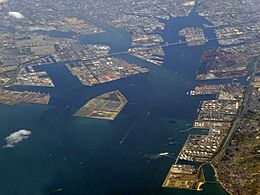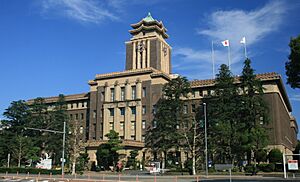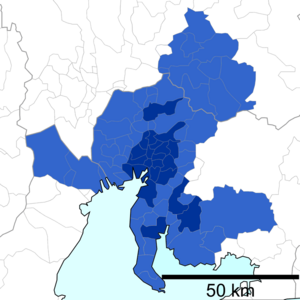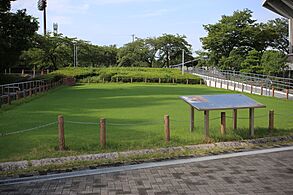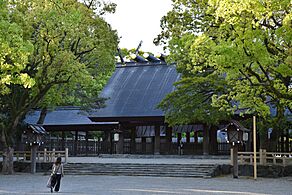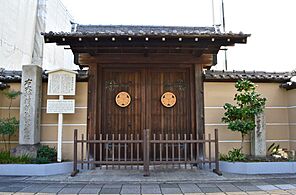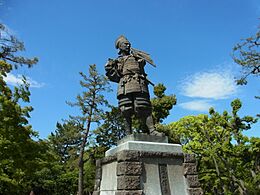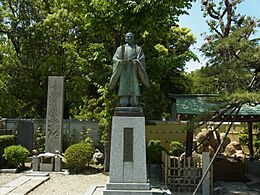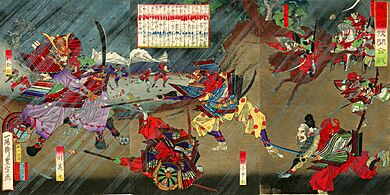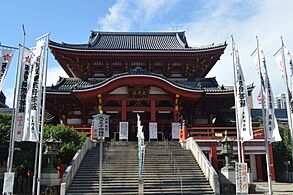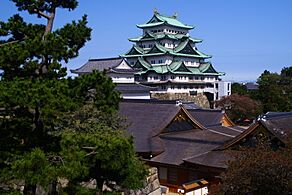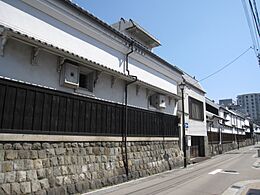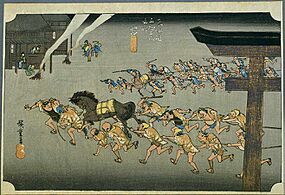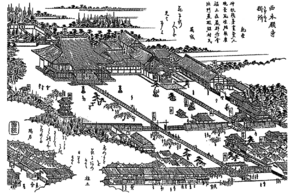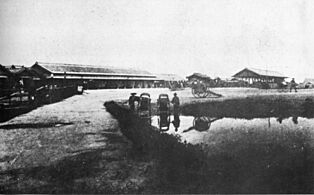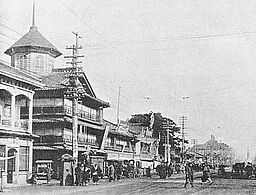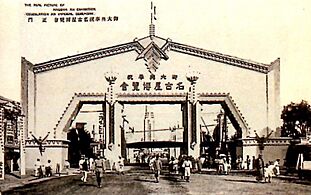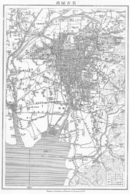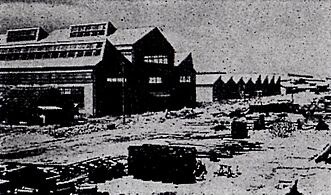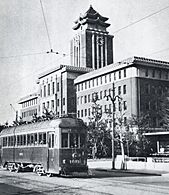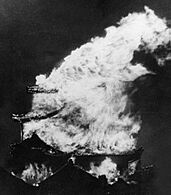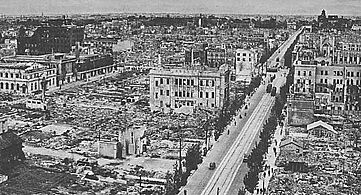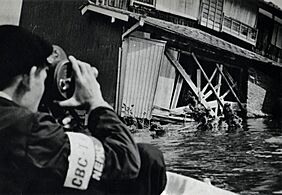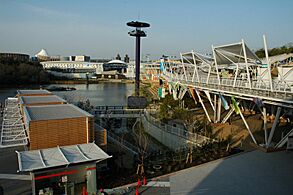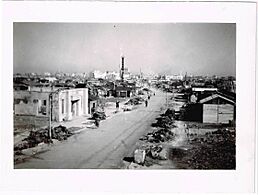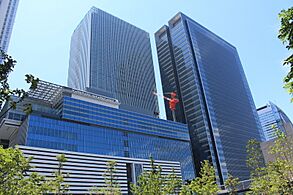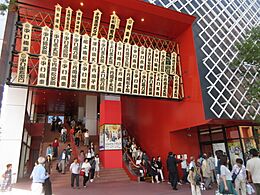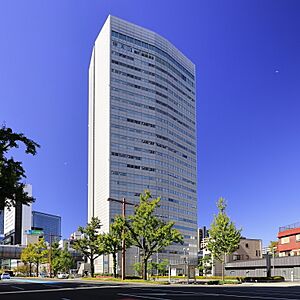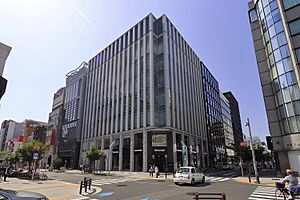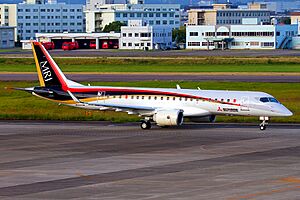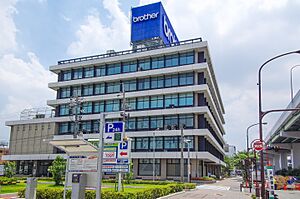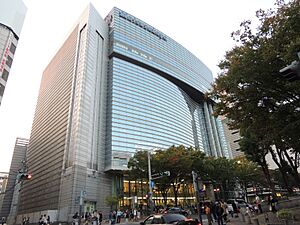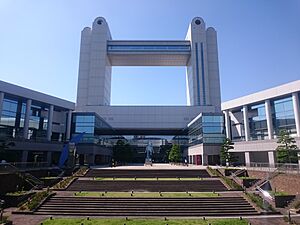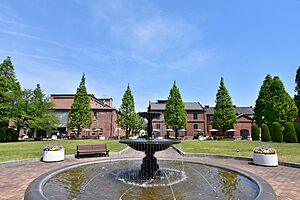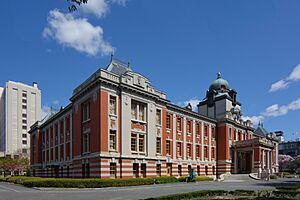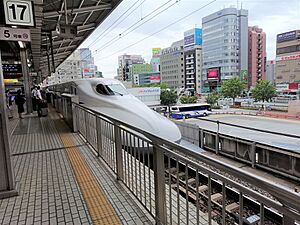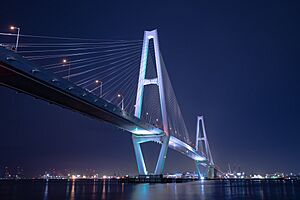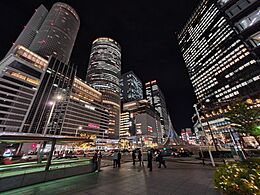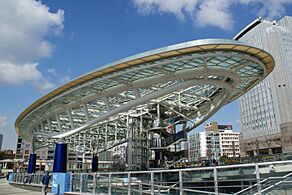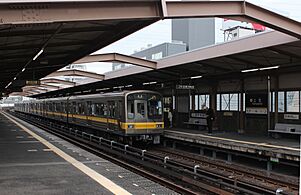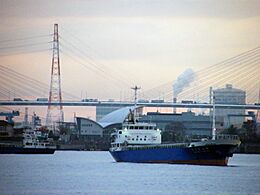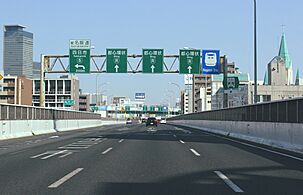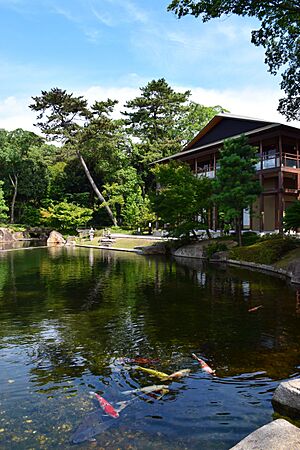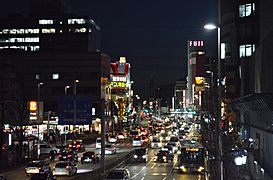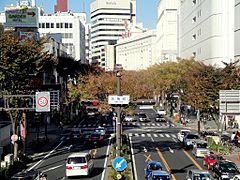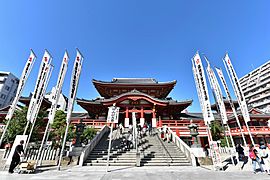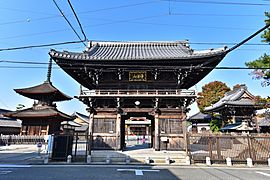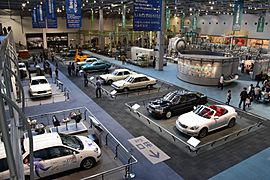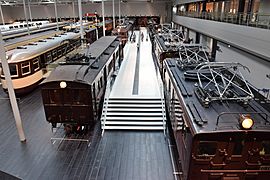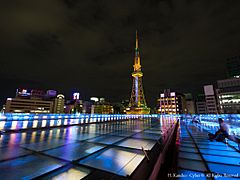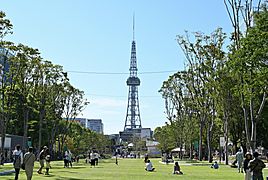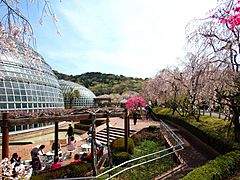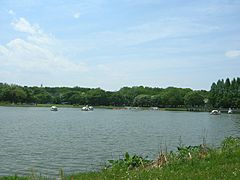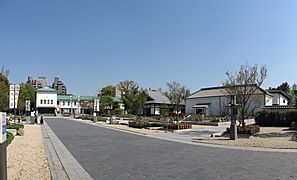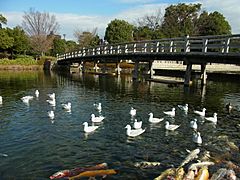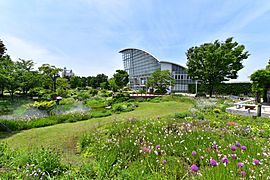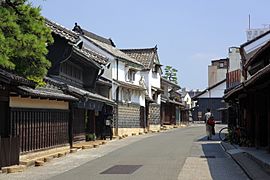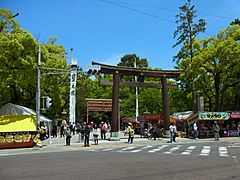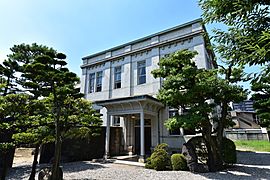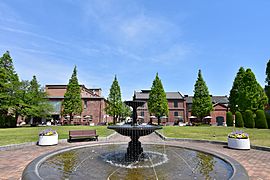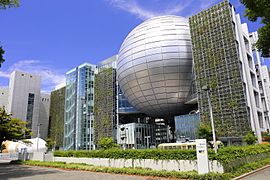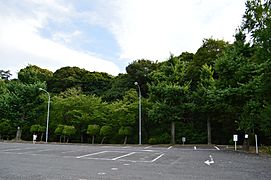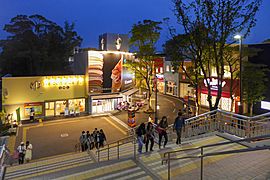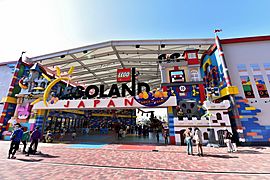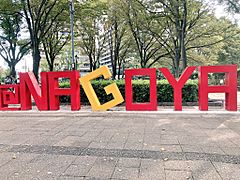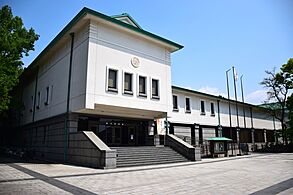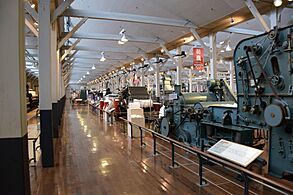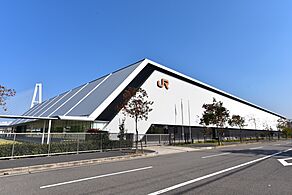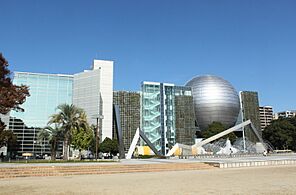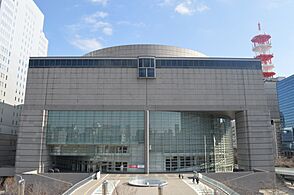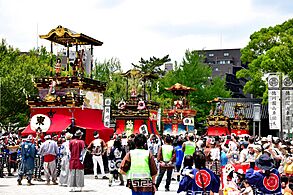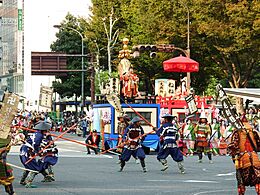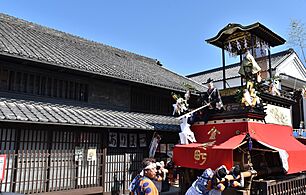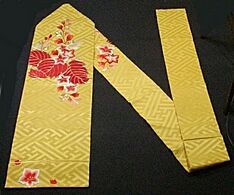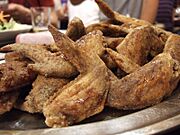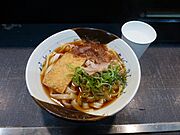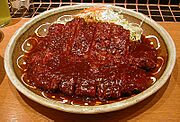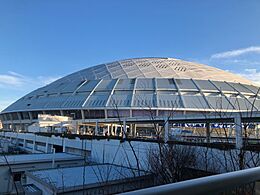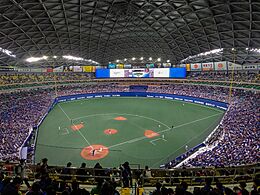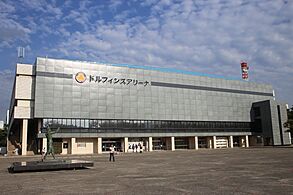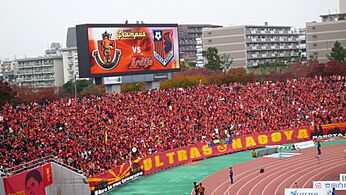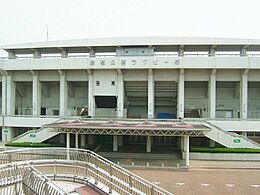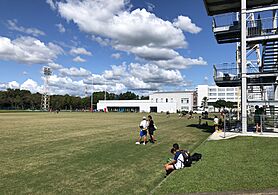Nagoya facts for kids
Quick facts for kids
Nagoya
名古屋市
|
|||
|---|---|---|---|
|
Skyline of Nagoya
Nagoya Castle
Nagoya TV Tower
Atsuta Shrine
Ōsu
Tokugawa Art Museum
Nagoya Port within Port of Nagoya Public Aquarium
|
|||
|
|||
| Nickname(s):
Chūkyō (中京)
|
|||

Location of Nagoya in Aichi Prefecture
|
|||
| Country | Japan | ||
| Region | Chūbu (Tōkai) | ||
| Prefecture | Aichi Prefecture | ||
| First official recorded | 199 AD | ||
| City Settled | November 1, 1889 | ||
| Area | |||
| • Designated city | 326.45 km2 (126.04 sq mi) | ||
| Population
(June 1, 2021)
|
|||
| • Designated city | 2,331,078 (3rd) | ||
| • Density | 7,140.6/km2 (18,494/sq mi) | ||
| • Metro | 10,240,000 (3rd) | ||
| Time zone | UTC+09:00 (Japan Standard Time) | ||
| – Tree | Camphor laurel (Cinnamomum camphora) |
||
| – Flower | Lilium | ||
| Phone number | 052-972-2017 | ||
| Address | 3-1-1 Sannomaru, Naka-ku, Nagoya-shi, Aichi-ken 460-0001 | ||
| Nagoya | |||||
|---|---|---|---|---|---|
"Nagoya" in kanji
|
|||||
| Japanese name | |||||
| Kanji | 名古屋 | ||||
| Hiragana | なごや | ||||
| Katakana | ナゴヤ | ||||
|
|||||
Nagoya (名古屋市, Nagoya-shi, [naꜜɡoja]) is a big city in the Chūbu region of Japan. It is the fourth-largest city in Japan by population. About 2.3 million people lived there in 2020. Nagoya is also the main city of the Chūkyō metropolitan area. This area is the third-largest in Japan, with over 10 million people.
Nagoya is on the Pacific coast in the middle of Honshu, Japan's largest island. It is the capital city of Aichi Prefecture. The Port of Nagoya is the biggest seaport in Japan.
In 1610, a powerful leader named Tokugawa Ieyasu moved the capital of Owari Province to Nagoya. This is when Nagoya Castle was rebuilt. In the 1900s, Nagoya grew very fast. It became a major industrial center for Japan. Factories made things like watches, bikes, and sewing machines. Later, they started making special steels, ceramics, and chemicals. The car, airplane, and shipbuilding industries also grew a lot.
Because of its factories, Nagoya was bombed during World War II. After the war, Nagoya's economy became more diverse. But it is still a very important place for industry and transportation in Japan. High-speed trains connect it to Tokyo, Kyoto, and Osaka. Many big companies have their main offices here, like Brother Industries, Ibanez, Lexus, and Toyota Tsusho. Nagoya also has important schools like Nagoya University.
Famous places in Nagoya include Atsuta Shrine, Higashiyama Zoo and Botanical Gardens, and Nagoya Castle. The city will host the 2026 Asian Games. This will be the third time a Japanese city hosts these games.
Contents
About Nagoya
What's in a Name?
The name Nagoya was once written with different Japanese characters. One idea is that the name comes from the word nagoyaka. This word means 'calm'.
Another name for Nagoya is Chūkyō (中京). This name means 'middle capital'. You can see this name in places like the Chūkyō Industrial Area.
Nagoya's Cityscape
Nagoya has many tall buildings and busy areas. You can see modern skyscrapers and historic landmarks. The city mixes old traditions with new developments.
- Gallery
-
Central business district from Midland Square (2015)
Nagoya's Geography and Divisions
Where is Nagoya Located?
Nagoya is north of Ise Bay on the Nōbi Plain. The city was built on slightly raised land to protect it from floods. This plain is one of Japan's most fertile areas. The Kiso River flows west along the city's edge. The Shōnai River comes from the northeast and turns south.
The human-made Hori River was built as a canal in 1610. It flows from north to south. These rivers helped with trade. Nagoya's central location in Japan helped it grow economically and politically.
- Gallery
Nagoya's Climate
Nagoya has a humid subtropical climate. This means it has hot, humid summers. Winters are cool. It rains throughout the year, but summer is wetter.
| Climate data for Nagoya (1991–2020 normals, extremes 1890–present) | |||||||||||||
|---|---|---|---|---|---|---|---|---|---|---|---|---|---|
| Month | Jan | Feb | Mar | Apr | May | Jun | Jul | Aug | Sep | Oct | Nov | Dec | Year |
| Record high °C (°F) | 21.0 (69.8) |
23.5 (74.3) |
25.8 (78.4) |
30.5 (86.9) |
34.8 (94.6) |
37.9 (100.2) |
39.6 (103.3) |
40.3 (104.5) |
38.0 (100.4) |
32.7 (90.9) |
27.2 (81.0) |
22.6 (72.7) |
40.3 (104.5) |
| Mean daily maximum °C (°F) | 9.3 (48.7) |
10.5 (50.9) |
14.5 (58.1) |
20.1 (68.2) |
24.6 (76.3) |
27.6 (81.7) |
31.4 (88.5) |
33.2 (91.8) |
29.1 (84.4) |
23.3 (73.9) |
17.3 (63.1) |
11.7 (53.1) |
21.1 (70.0) |
| Daily mean °C (°F) | 4.8 (40.6) |
5.5 (41.9) |
9.2 (48.6) |
14.6 (58.3) |
19.4 (66.9) |
23.0 (73.4) |
26.9 (80.4) |
28.2 (82.8) |
24.5 (76.1) |
18.6 (65.5) |
12.6 (54.7) |
7.2 (45.0) |
16.2 (61.2) |
| Mean daily minimum °C (°F) | 1.1 (34.0) |
1.4 (34.5) |
4.6 (40.3) |
9.7 (49.5) |
14.9 (58.8) |
19.4 (66.9) |
23.5 (74.3) |
24.7 (76.5) |
21.0 (69.8) |
14.8 (58.6) |
8.6 (47.5) |
3.4 (38.1) |
12.3 (54.1) |
| Record low °C (°F) | −10.3 (13.5) |
−9.5 (14.9) |
−6.8 (19.8) |
−2.1 (28.2) |
2.8 (37.0) |
8.2 (46.8) |
14.0 (57.2) |
14.4 (57.9) |
9.5 (49.1) |
1.5 (34.7) |
−2.7 (27.1) |
−7.2 (19.0) |
−10.3 (13.5) |
| Average precipitation mm (inches) | 50.8 (2.00) |
64.7 (2.55) |
116.2 (4.57) |
127.5 (5.02) |
150.3 (5.92) |
186.5 (7.34) |
211.4 (8.32) |
139.5 (5.49) |
231.6 (9.12) |
164.7 (6.48) |
79.1 (3.11) |
56.6 (2.23) |
1,578.9 (62.16) |
| Average snowfall cm (inches) | 4 (1.6) |
5 (2.0) |
0 (0) |
0 (0) |
0 (0) |
0 (0) |
0 (0) |
0 (0) |
0 (0) |
0 (0) |
0 (0) |
3 (1.2) |
12 (4.7) |
| Average precipitation days (≥ 0.5 mm) | 6.3 | 7.2 | 9.8 | 10.4 | 10.7 | 12.7 | 13.0 | 9.4 | 11.9 | 10.0 | 7.0 | 7.5 | 115.9 |
| Average relative humidity (%) | 64 | 60 | 58 | 59 | 64 | 71 | 73 | 69 | 70 | 68 | 66 | 66 | 66 |
| Mean monthly sunshine hours | 174.5 | 175.5 | 199.7 | 200.2 | 205.5 | 151.8 | 166.0 | 201.3 | 159.6 | 168.9 | 167.1 | 170.3 | 2,141 |
| Average ultraviolet index | 2 | 4 | 6 | 7 | 9 | 10 | 10 | 10 | 8 | 6 | 3 | 2 | 6 |
| Source: Japan Meteorological Agency | |||||||||||||
Nagoya's Wards and Population
Nagoya is divided into 16 smaller areas called wards. Each ward has its own local government services.
| Wards of Nagoya | |||||||
|---|---|---|---|---|---|---|---|
| Place Name | Map of Nagoya | ||||||
| Rōmaji | Kanji | Population | Land area in km2 | Pop. density per km2 | |||
| 1 | Atsuta-ku | 熱田区 | 66,318 | 8.20 | 8,088 | ||
| 2 | Chikusa-ku | 千種区 | 165,863 | 18.18 | 9,123 | ||
| 3 | Higashi-ku | 東区 | 82,939 | 7.71 | 10,757 | ||
| 4 | Kita-ku | 北区 | 163,555 | 17.53 | 9,330 | ||
| 5 | Meitō-ku | 名東区 | 165,287 | 19.45 | 8,498 | ||
| 6 | Midori-ku | 緑区 | 247,475 | 37.91 | 6,528 | ||
| 7 | Minami-ku | 南区 | 136,015 | 18.46 | 7,368 | ||
| 8 | Minato-ku | 港区 | 143,913 | 45.64 | 3,153 | ||
| 9 | Mizuho-ku | 瑞穂区 | 107,622 | 11.22 | 9,592 | ||
| 10 | Moriyama-ku | 守山区 | 176,298 | 34.01 | 5,184 | ||
| 11 | Naka-ku – administrative center | 中区 | 90,918 | 9.38 | 9,693 | ||
| 12 | Nakagawa-ku | 中川区 | 220,782 | 32.02 | 6,895 | ||
| 13 | Nakamura-ku | 中村区 | 135,134 | 16.30 | 8,290 | ||
| 14 | Nishi-ku | 西区 | 150,480 | 17.93 | 8,393 | ||
| 15 | Shōwa-ku | 昭和区 | 110,436 | 10.94 | 10,095 | ||
| 16 | Tenpaku-ku | 天白区 | 164,522 | 21.58 | 7,624 | ||
The first count of people in Nagoya was in 1889. It showed 157,496 residents. The population reached 1 million in 1934. By 2010, about 2.26 million people lived there. The city covers an area of 326.45 square kilometers. The larger Nagoya metropolitan area includes parts of Mie and Gifu prefectures. It has about 10 million people.
| Historical population | ||
|---|---|---|
| Year | Pop. | ±% |
| 1873 | 125,193 | — |
| 1889 | 157,496 | +25.8% |
| 1920 | 677,452 | +330.1% |
| 1925 | 842,835 | +24.4% |
| 1930 | 991,833 | +17.7% |
| 1935 | 1,182,837 | +19.3% |
| 1940 | 1,415,117 | +19.6% |
| 1945 | 971,374 | −31.4% |
| 1950 | 1,157,263 | +19.1% |
| 1955 | 1,420,572 | +22.8% |
| 1960 | 1,697,093 | +19.5% |
| 1965 | 1,935,430 | +14.0% |
| 1970 | 2,036,053 | +5.2% |
| 1975 | 2,079,740 | +2.1% |
| 1980 | 2,087,902 | +0.4% |
| 1985 | 2,116,381 | +1.4% |
| 1990 | 2,154,793 | +1.8% |
| 1995 | 2,152,184 | −0.1% |
| 2000 | 2,171,557 | +0.9% |
| 2005 | 2,215,062 | +2.0% |
| 2010 | 2,263,907 | +2.2% |
| 2015 | 2,295,638 | +1.4% |
| 2020 | 2,330,178 | +1.5% |
Nagoya's History
Early Beginnings
Long ago, in the Jomon and Yayoi periods, people lived in the Nagoya area. The Ōguruwa Shell Midden shows signs of early settlements. During the Kofun period, large burial mounds like the Danpusan Kofun were built here.
The Atsuta Shrine is very old. It is said to hold a special sword called Kusanagi no Tsurugi. This sword is one of Japan's most important treasures.
- The Origins of Nagoya
Medieval Times
In the Heian period, the Seigan-ji temple was built. It is believed that Minamoto no Yoritomo, who founded the Kamakura government, was born in Nagoya.
-
The Seigan-ji was the birthplace of Minamoto no Yoritomo.
Nagoya's Growth in Early Modern Ages
During the Azuchi–Momoyama period, three powerful leaders helped unite Japan. They were Oda Nobunaga, Toyotomi Hideyoshi, and Tokugawa Ieyasu. All of them had strong ties to the Nagoya area. In 1610, Tokugawa Ieyasu moved the capital to Nagoya.
In 1560, the Battle of Okehazama happened near Nagoya. In this battle, Oda Nobunaga won. This victory made him one of the most important leaders.
- Historical Figures of Nagoya
-
Battle of Okehazama (1560)
During the Edo period, Nagoya Castle was built. Materials from Kiyosu Castle were used. The whole town of Kiyosu, with about 60,000 people, moved to the new town around Nagoya Castle. The Atsuta Shrine became a stop on the important Tōkaidō road. This road connected Kyoto and Edo (now Tokyo). A town grew around the shrine to help travelers. The castle town and shrine town together formed the city.
Modern Nagoya: Industry and War
In the Meiji period, Japan's government changed. Nagoya became a city on October 1, 1889. It grew into a major industrial center. Famous pottery towns like Tokoname and Seto were part of its economic area. Other industries included cotton and mechanical dolls.
In 1920, Mitsubishi Aircraft Company was started in Nagoya. It became one of Japan's biggest airplane makers. Nagoya's central location and good transport links helped the aviation industry grow.
-
Hirokoji in Nagoya during the Meiji era
-
Toyota Motor Corporation plant (1938)
During World War II, Nagoya was bombed. It was a target because of its many factories. These factories made airplanes and other war supplies. On May 14, 1945, Nagoya Castle was hit and mostly destroyed. The main building was rebuilt in 1959.
After the war, Nagoya rebuilt itself. It became a top industrial and manufacturing city again. It also started hosting big events. For example, it hosted Expo 2005 and the Nagoya Protocol conference in 2010.
Public Services in Nagoya
Nagoya has many public services to help its citizens. These include police, fire departments, and post offices.
Police and Fire Services
The Aichi Prefectural Police has police stations in each of Nagoya's 16 wards. The Nagoya City Fire Bureau also has fire departments in every ward.
Post Offices and Libraries
Nagoya has many post offices, including the Nagoya Central Post Office. The city also has many libraries. The Aichi Prefectural Library and the Nagoya City Library are major ones. There are also smaller libraries in each ward.
Cultural Facilities
Nagoya has many playhouses and cultural places. These include the Aichi Arts Center and the Chunichi Theatre. They host various performances and events.
Nagoya's International Connections
The Nagoya International Center helps with international exchange. It has the U.S. Consulate and a United Nations office.
Nagoya is twinned with several cities around the world. These are called sister cities.
Sister Cities Around the World
| City | Country | State | Since |
|---|---|---|---|
| Los Angeles | California | April 1, 1959 | |
| Houston | Texas | May 20, 1963 | |
| Mexico City | Mexico City | February 16, 1978 | |
| Nanjing | Jiangsu | December 21, 1978 | |
| Sydney | New South Wales | September 16, 1980 | |
| Turin | Piedmont | May 27, 2005 | |
| Reims | Grand Est | October 20, 2017 |
The sister city link with Nanjing, China, was paused in 2012. This happened after comments by Nagoya's mayor.
Partner Cities in Japan
Nagoya also has partner cities within Japan. These include Toyota and Nakatsugawa.
Nagoya's Economy
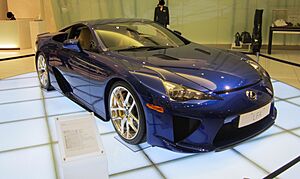
Nagoya is the center of a large economic area called Greater Nagoya. This area makes a lot of Japan's trade surplus.
Automotive Industry
The main industry in Nagoya is making cars. Many car companies have their main offices here. Toyota's luxury brand Lexus is based near Nagoya. Other big car parts companies like Denso are also here.
Aviation Industry
Making airplanes has been important in Nagoya for a long time. During World War II, the Mitsubishi A6M Zero fighter plane was built here. Today, Mitsubishi Aircraft Corporation is based at Nagoya Airfield. They make the Mitsubishi Regional Jet (MRJ) aircraft. This is the first airliner designed in Japan since the 1960s.
Ceramics Industry
The Nagoya region has a long history of making pottery and porcelain. This is because there is good clay available. Famous types of pottery like Seto and Tokoname ware come from this area. Today, companies like INAX still make industrial ceramics here.
Technology and Retail
Nagoya is known for traditional mechanical puppets called "karakuri ningyō." Robot technology is also a growing industry. Companies like Brother Industries, known for office electronics, are based here.
Retail is also important. Traditional department stores like Matsuzakaya started in Nagoya.
Education in Nagoya
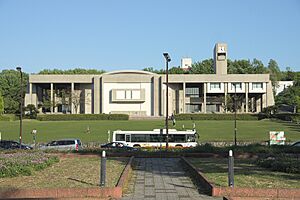
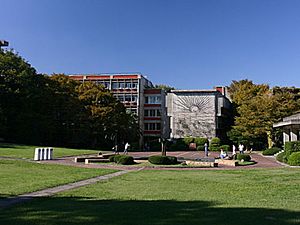
Nagoya has many schools, from elementary to university level. There are also international schools.
Universities in Nagoya
Many colleges and universities are in Nagoya, mostly in the eastern part of the city. Some of the oldest were founded in the Meiji era. Nagoya University started as a medical school in 1871. It has had seven Nobel Prize winners in science.
Nanzan University was started as a high school in 1932. It grew to include a college. Some universities focus on engineering and technology. These include Nagoya University Engineering school and Nagoya Institute of Technology. They get support from companies like Toyota.
Other universities in Nagoya include Chukyo University and Meijo University. The Hōsa Library is very old, dating back to the 1600s. It holds many classic books. The Nagoya City Archives also has a large collection of documents.
- National Universities
- Nagoya University (名古屋大学, Nagoya Daigaku)
- Nagoya Institute of Technology (名古屋工業大学, Nagoya Kōgyō Daigaku)
- Prefectural University
- Aichi Prefectural College of Nursing & Health (愛知県立看護大学, Aichi kenritsu kango Daigaku)
- Nagoya City University (名古屋市立大学, Nagoya shiritsu Daigaku)
- Private Universities
- Aichi University (愛知大学, Aichi Daigaku)
- Aichi Gakuin University (愛知学院大学, Aichi gakuin Daigaku)
- Aichi Shukutoku University (愛知淑徳大学, Aichi Shukutoku Daigaku)
- Aichi Toho University (愛知東邦大学, Aichi Toho Daigaku)
- Chukyo University (中京大学, Chūkyō Daigaku)
- Daido University (大同大学, Daidō Daigaku)
- Doho University (同朋大学, Dōhō Daigaku)
- Kinjo Gakuin University (金城学院大学, Kinjō Gakuin Daigaku)
- Meijo University (名城大学, Meijō Daigaku)
- Nagoya College of Music (名古屋音楽大学, Nagoya Ongaku Daigaku)
- Nagoya Gakuin University (名古屋学院大学, Nagoya Gakuin Daigaku)
- Nagoya Women's University (名古屋女子大学, Nagoya Joshi Daigaku)
- Nanzan University (南山大学, Nanzan Daigaku)
- Sugiyama Jogakuen University (椙山女学園大学, Sugiyama Jogakuen Daigaku)
- Tokyo University of Social Welfare (東京福祉大学, Tokyo Fukushi Daigaku)
- Tokai Gakuen University (東海学園大学, Tokai Gakuen Daigaku)
- Toyota Technological Institute (豊田工業大学, Toyota Kōgyō Daigaku)
Getting Around Nagoya

Airports Serving Nagoya
Nagoya is served by Chubu Centrair International Airport (NGO). This airport is built on an artificial island. It has many international and domestic flights.
Another airport is Nagoya Airfield (Komaki Airport, NKM). It is used for smaller planes and as an airbase.
Train Travel in Nagoya
Nagoya Station is one of the world's largest train stations. It is on the Tōkaidō Shinkansen line, which is a high-speed train. Other train lines also run through Nagoya Station. JR Central, which runs the Shinkansen, has its main office here.
The Nagoya Subway provides train service within the city.
Buses and Roads
Many bus companies operate routes throughout Nagoya. These buses work with the train system to help people get around.
Nagoya has a well-planned grid of streets. Many expressways and national routes pass through or around the city.
Seaport
Nagoya Port is Japan's largest port for international trade. Many goods, including cars from Toyota, are shipped from this port.
Fun Things to See in Nagoya
Nagoya has many interesting places to visit. The two most famous are Atsuta Shrine and Nagoya Castle.
- Atsuta Shrine is one of Japan's most respected shrines. It is said to hold a special sword, but it is not shown to the public. The shrine hosts about 70 festivals each year. It also has over 4,400 national treasures.
- Nagoya Castle was built in 1612. Much of it was destroyed in World War II. But it was rebuilt in 1959. The castle is famous for its two golden tiger-headed carp on the roof. These are a symbol of Nagoya.
Other fun places to visit include:
- Nagoya TV Tower and Hisaya-Ōdori Park
- JR Central Towers at Nagoya Station
- Midland Square: This building has Japan's highest outdoor observation deck.
- The Port of Nagoya area, with the Port of Nagoya Public Aquarium.
- Higashiyama Zoo and Botanical Gardens and the Higashiyama Sky Tower
- The Toyota Commemorative Museum of Industry and Technology
- Danpusan Kofun: The largest ancient burial mound in Aichi.
- The Noritake factory: You can learn about the history of this fine china company.
- The SCMaglev and Railway Park
- The Ōsu shopping district and nearby temples, Ōsu Kannon and Banshō-ji
- The Tokugawa Art Museum and the Tokugawa Garden
- The Nagoya City Science and Art Museums
- Legoland Japan, a fun theme park.
Gallery of Nagoya Sights
Exploring the Surrounding Area
Nagoya is a great starting point for trips to nearby places. You can visit Inuyama, the Little World Museum of Man, or Meiji Mura. Other places include Tokoname and Himakajima. Within two hours, you can reach Gifu, Ise Shrine, and Takayama, Gifu.
Nagoya's Culture
Nagoya was once a major trading city and a political center. The local lords, the Owari Tokugawa, supported trade and the arts. This helped culture to grow. After World War II, the city's strong economy helped its art and culture scene grow again.
Museums in Nagoya
Nagoya has many museums. They cover traditional and modern art, crafts, and science.
Nagoya Castle has a museum about its history. The Honmaru Palace was rebuilt in 2018. It shows how buildings looked in feudal times. The Tokugawa Art Museum has treasures from the Owari Tokugawa family. It includes old scrolls of The Tale of Genji. The Nagoya Noh Theater has items from Noh theater. The Nagoya City Museum shows the city's history.
The Nagoya City Art Museum shows paintings and sculptures. Modern art is at the Aichi Arts Center. The Noritake Garden shows the art of porcelain. Toyota has two museums: the Toyota Automobile Museum and the Toyota Commemorative Museum of Industry and Technology.
The Nagoya City Tram & Subway Museum has old trams and subway cars. The Nagoya City Science Museum is also popular. The SCMaglev and Railway Park opened in 2011. It has many trains from the Central Japan Railway Company.
Theatres and Festivals
Nō and Kyōgen theater have been in Nagoya since feudal times. The Nagoya Noh Theater continues this tradition. Kabuki theater is also performed at Misono-za.
In 1992, the Aichi Arts Center opened. It is a big place for performing arts. The Nagoya Philharmonic Orchestra performs there.
Nagoya has many unique local festivals. Major events include the June Atsuta Festival and the October Nagoya Festival.
Nagoya Dialect and Handicrafts
People in Nagoya speak the Nagoya dialect. It is similar to standard Japanese.
Nagoya is known for its traditional handicrafts. These include:
- Arimatsu and Narumi dye: This is a special way of tie-dyeing fabrics. It takes a long time to make.
- Geta clog straps: These are straps for wooden clogs. They are made from cotton velvet.
- Shippo: This is a type of enamelware. The patterns look almost clear.
- Candles: Japanese candles are made from wax layers. They produce less smoke. Artists paint colorful patterns on them.
- Yuzen: This is an art of dyeing silk. The designs are often bright and colorful.
- Sekku Ningyo: These are festival dolls. Nagoya craftsmen are known for making them.
- Nagoya obi: This is a type of sash used with a kimono. It was developed in the 1920s. It is the most common type of obi today.
- Pottery: Seto ware and Tokoname ware are famous pottery types from this region.
- Netsuke: These are small, carved ornaments.
Nagoya Cuisine
Nagoya is famous for its unique local food, called Nagoya cuisine (名古屋めし, Nagoya meshi). Some popular dishes are:
- Tebasaki: Chicken wings with a sweet sauce and sesame seeds.
- Tenmusu: A rice ball with deep-fried shrimp inside.
- Kishimen: Flat udon noodles served in a light soup.
- Red miso: Many dishes use red miso, like miso katsu (pork cutlet with miso sauce).
- Hitsumabushi: A rice dish with grilled eel. It can be eaten in three different ways.
- Miso nikomi udon: Thick udon noodles cooked in miso soup.
Sports in Nagoya
Nagoya is home to several professional sports teams.
| Club | Sport | League | Venue | Established |
|---|---|---|---|---|
| Chunichi Dragons | Baseball | NPB (Ce.League) | Nagoya Dome, Nagoya Stadium | 1936 |
| Toyota Verblitz | Rugby | League ONE | Paloma Mizuho Rugby Stadium, Toyota Stadium | 1941 |
| Nagoya Diamond Dolphins | Basketball | B.League | Aichi Prefectural Gymnasium, Nagoya Higashi sport center | 1950 |
| Toyotsu Fighting Eagles Nagoya | Basketball | B.League | Biwajima Sports Center | 1957 |
| Wolf Dogs Nagoya | Volleyball | V.LEAGUE | TOYODA GOSEI Memorial Gymnasium (ENTRIO) | 1961 |
| Daido Steel Phenix | Handball | JHL | Daido Steel Hoshizaki Gym | 1964 |
| Daido Steel Red Star | Volleyball | V.LEAGUE | Daido Steel Hoshizaki Gym | 1968 |
| Nagoya Cyclones | American football | X-League | Nagoya Minato Stadium | 1980 |
| Nagoya Frater | Field hockey | Hockey Japan League | Shōnai Greens Park | 1985 |
| Nagoya Grampus | Football | J.League | Mizuho Athletic Stadium, Toyota Stadium | 1993 |
| Nagoya Oceans | Futsal | F.League | Takeda Teva Ocean Arena | 2006 |
In 2007, the Chunichi Dragons won the Japan Series in baseball. In 2010, Nagoya Grampus won the J. League soccer championship. A sumo wrestling tournament is held every July. The city also hosts golf and marathon events.
Nagoya will host the 2026 Asian Games. This is a big sports event for athletes from all over Asia.
Famous People from Nagoya
Historical Figures
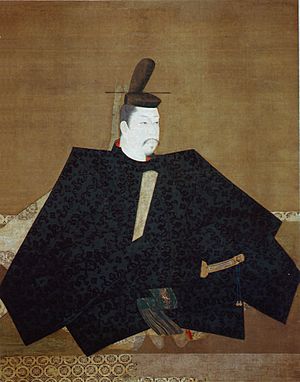
Minamoto no Yoritomo was the first shōgun (military ruler) of Japan. He was born in Nagoya.
Three famous samurai leaders who helped unite Japan in the 1500s have strong connections to Nagoya:
- Oda Nobunaga (1534–1582)
- Toyotomi Hideyoshi (1536–1598)
- Tokugawa Ieyasu (1543–1616)
-
=== Inventors and Business Leaders ===
-
=== Artists and Entertainers ===
-
Nagoya is home to many talented musicians, actors, and artists.
-
* '''Musicians and Composers'''
- Actors
- Kaede Hondo
- Akari Kitō
- Naoko Mori
- Emi Takei
- Hiroshi Tamaki
- Yūki Yamada
-
=== Athletes ===
-
Many athletes are from Nagoya, including figure skaters and baseball players.
Manga Artists
- Akira Toriyama, creator of Dragon Ball.
See also
 In Spanish: Nagoya para niños
In Spanish: Nagoya para niños


